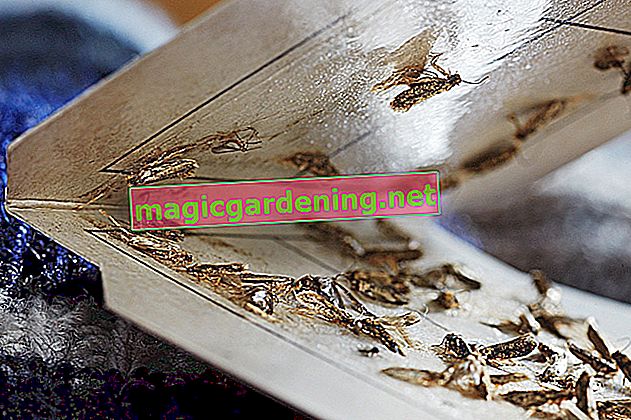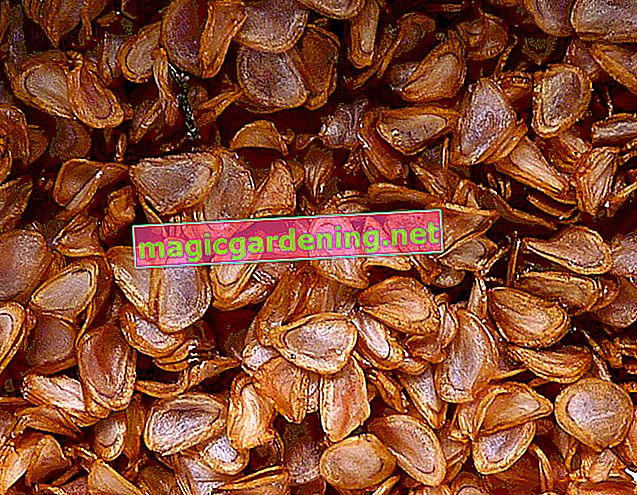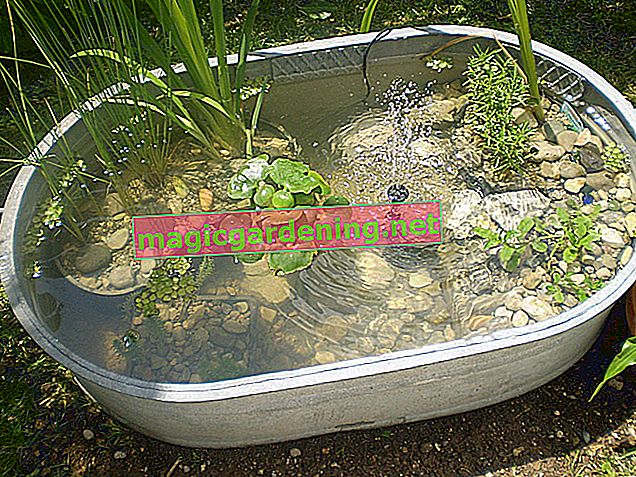
the essentials in brief
- Flour moths are widespread storage pests and belong to the group of moths (Pyralidae).
- The voracious caterpillars, which destroy food over a period of up to 60 days, are harmful.
- A wide range of non-toxic agents and procedures are available for combating flour moth maggots.
Fighting flour moths - what helps?
Flour moths are dreaded storage pests. The moths and their maggots contaminate dry food with their leftovers. Feces and thread-like webs offer mites, fungi and bacteria ideal living conditions. This fact makes flour moths a noxious plague. The use of chemical insecticides is frowned upon in the immediate living environment. Victims of flour moth infestations are not at a loss, however. The following table provides a comprehensive overview of the non-toxic control of maggots, eggs and butterflies:
also read
- German cockroach - Dangerous plague in the kitchen
- Holy herb - tips for use in the household and kitchen
- Fight fruit flies in the kitchen with butterwort
| Immediate action | Home remedies | non-toxic control | Control / decimation | prevention |
|---|---|---|---|---|
| Vacuum cupboards / containers | Freeze | Parasitic wasps | Pheromone trap | Essential oils |
| Clean with hot water | Heat | Diatomaceous earth | Glue trap | Fly screens |
| Wipe with vinegar | Baking soda | Throw away contaminated material | Airtight storage | |
| Heat the niches with a hairdryer | Lavender, laurel |
This table lists proven control strategies to get rid of flour moths and maggots without the use of toxic chemicals. Have any of the recommended methods piqued your interest? Then read on. Detailed explanations and instructions with practical tips and tricks follow.
Tips
Flour moths leave nets and cocoons in many places in the house. Each cocoon can have a nest with several hundred eggs. Regularly check the pantry and shelves on the wall in order to destroy treacherous webs with a vacuum cleaner or hairdryer.
Where do flour moths come from?

Sustainable control of flour moths is crowned with maximum success if you are familiar with the origin and life cycle of the pests. We therefore invite you to take a brief stroll through the living habits of flour moths, which cause us humans so much uneasiness.
Flour moths are small butterflies from the borer family. It is not the small butterflies that cause the damage in the kitchen, but their offspring in the form of maggots. The females lay 50 to 500 eggs, preferably in flour or muesli, also in tea and other dry foods. Within a few days, a larva hatches from each egg and goes through a total of six caterpillar stages. This process can take up to three months. During this time, the worms eat their way through the food, leaving a trail of feces and sticky threads behind them.
Flour moths get into your food supplies in two ways. The butterflies use tilted windows and open doors as entrance gates. The pests are more frequently introduced through packaged food. Plastic, cardboard or paper are no obstacles for the pests. With their powerful mouthparts, the voracious maggots simply bite their way through the packaging material into the flour moth's paradise.
Digression
Recognize flour moths and maggots
Locations in the kitchen and in food give the first indications of a flour moth infestation. The external appearance removes any final doubts about the true identity of the culprits. The butterflies and maggots are characterized by the following distinguishing features: The moths are colored lead gray and have a wingspan of 20-25 mm with a body length of 10-14 mm. The clearly lighter rear wings with a whitish, fringed edge are striking. Maggots are whitish with a brown head. A hatched larva is almost 1 mm long. The caterpillar reaches a length of up to 20 mm by the time it pupates.Getting rid of flour moths - emergency measures
YoutubeFlour moth infestation is associated with a high disgust factor and arouses the urgent desire to destroy the pests as quickly as possible. In the early stages, emergency measures can help you get rid of nasty moths, eggs and maggots. A step-by-step cleaning in the following steps has proven to be effective:
- Vacuum cupboards and drawers thoroughly with a vacuum cleaner
- Clean sites with hot water
- Soak a rag with vinegar and a little peppermint oil and wipe off
- Heat niches, gaps, cracks and panels with a hairdryer
- Vacuum and wipe again (dispose of vacuum cleaner filter immediately)
Please dispose of contaminated food in the garbage can. Exceptionally, packaging does not end up in the yellow sack, but also ends up in the household waste. You can carefully clean storage jars in the dishwasher or in hot detergent water. The pheromone trap is a non-toxic control instrument for the success of your emergency measures. Put at least one trap in the kitchen. This guide explains how glue traps work and how to handle them properly in a separate section.
Home remedies against flour moth infestation

Flour moths are tough. With conventional home remedies against pest infestation, no significant successes can be achieved in the control. At best, essential oils, lavender or cedarwood are useful as an effective preventive measure. Thermal methods are a good choice to combat acute infestations with voracious maggots and cunning butterflies. What has proven to be excellent in the fight against woodworms can also destroy flour moths. This is how it works:
- Freeze contaminated food and containers for 2 days
- Alternatively: heat infected supplies and containers (if suitable)
- Place in the oven for 90-120 minutes at 60 ° -80 ° top and bottom heat
Freezing and heating reliably kills eggs, maggots and butterflies. The food is no longer suitable for consumption. Nevertheless, thermal treatment prior to disposal is advisable as a biological procedure against carry-over or re-infestation.
If reusable storage containers, drawers or cupboards are too big for the freezer or oven, subject the infected objects to thermal combating outside. Under the protection of a foil cover, winter frost or summer heat destroy the pests down to the last niche within one to two days.
Make flour moth trap yourself - this is how it works

Flour moths' fondness for flour turns into disaster when baking soda comes into play. Soda is not only an important component of baking powder, it also has other useful properties. This includes the fact that sodium hydrogen carbonate changes the pH value in the organism of a larva in such a way that it dies. This fact favors the effectiveness of a flour moth trap, which you can easily build yourself. That is how it goes:
- In a bowl, mix 4 parts of baking powder with 1 part of flour
- Pull the cling film over the bowl
- Pierce the foil in several places with a thin sewing needle
- Place the trap in the kitchen, pantry, or near food
Flour moth females smell the flour as the preferred storage place for eggs. The nocturnal moths squeeze through the holes and place the nest in the middle of the flour and baking soda mixture. When the caterpillars hatch, they not only eat flour, but also ingest baking powder and die. The moths can no longer find a way out of the trap, so they cannot make another nest in the kitchen.
Control with parasitic wasps - this is how it works

Ichneumon wasps parasitize meal moth eggs and nip the disgusting plague in the bud. The hatchling species Trichogramma evanescens has specialized in food moth eggs as hosts for its own offspring. In living spaces, ichneumon wasps find ideal conditions, so that parasitic rates of up to 90 percent can be achieved. This fact makes the 0.4 mm small, extremely delicate insects the most successful enemies of flour moths. If all food moths are destroyed, parasitic wasps either migrate or perish. Consequently, there is no reason to fear that you will have to contend with an ichneumon wasp plague in the future.
You can buy the powerful protection aid for fighting flour moths in specialist shops. You will receive cards with up to 3000 ichneumon wasp pupae in different stages of development. The cards are delivered in 3 partial deliveries. This step-by-step procedure over 9 to 10 weeks promises optimal control success. Thats how it works:
- Order parasitic wasps, for example 3 x 4 or 3 x 8 cards from Schneckenprofi or another specialist dealer
- The first partial delivery with 4 or 8 cards and 3000 parasitic wasp pupae arrives
- Unpack and distribute the cards according to the enclosed instructions
- Ichneumon wasps hatch and tackle the flour moth problem
- After 3 weeks, lay out the next partial delivery with doll cards in the kitchen
- Bring the third partial delivery into position after a further 3 weeks
Your task in fighting is limited to the strategically correct distribution of each partial delivery. The long application over a period of three months guarantees the best possible control success.
Tips
Ichneumon wasps not only provide valuable support in combating flour moths. The filigree insects also have annoying fruit flies in their sights.
Destroy flour moths with diatomaceous earth
The fight against meal moths with even more insects in the form of parasitic wasps does not meet with unanimous approval. After all, those affected can bring up to 36,000 parasitic wasps into the house with just 3 x 4 doll cards. If you don't want to make friends with this squad of insects in the kitchen, you can use diatomaceous earth. It is powdered sedimentary rock, also known as kieselguhr.
You can buy diatomaceous earth in drug stores, pharmacies and on the Internet. Spread the non-toxic powder in all suspicious places in the house. Diatomaceous earth is ideal for killing flour moth maggots in inaccessible corners and niches. A positive side effect: Diatomaceous earth kills other pests such as lice, ticks, mites and silverfish.
Pheromone trap - control and extra decimation

Flour moths are nocturnal and masters of camouflage. It is therefore problematic to assess the success of a control measure. For this purpose there is the pheromone trap. This is a glue trap with a special sexual attractant for male flour moths. The trap trickes males willing to mate into the presence of females. The attracted butterflies stick to the board. By adding the number, you can estimate the infestation pressure and decide how to proceed. In addition, pheromone traps decimate the number of male food moths and optimize the control success.
Ready-to-use pheromone traps against food moths are available from drug stores, pharmacies, garden centers, hardware stores and internet shops. The glue traps are odorless, have no toxins in their luggage and serve as a control instrument and moth trap for about 3 months.
Where threatens flour moth infestation

Flour moths are not picky about potential egg storage locations. In fact, the name disguises the fact that the pests can contaminate far more food than flour. The following list sums up where the voracious moth maggots can settle:
| Scatterable foods | dried foods | more locations |
|---|---|---|
| Flour | Cereal flakes | Dry dog food |
| Sauce binder | Tea, coffee, cocoa | Dry cat food |
| Semolina | Dried fruit | Birdseed |
| Sugar, salt | Dry peas | cat litter |
| Chocolate sprinkles | Cornflakes, muesli | |
| Spices | Herbs |
Preventing flour moths - tips & tricks
Flour moths abhor peppermint oil. If female butterflies smell all kinds of essential oils in the kitchen or in the pantry, they turn away in disgust and run away. We have compiled these and other means of prevention for you below:
- Put lavender in sachets in the kitchen
- Arrange the bay leaves in drawers and stick them on the inside of storage containers
- Examine food packaging for holes before buying and may not buy it
- Store freshly purchased food in airtight containers made of glass, metal or plastic
- Equip windows and balcony doors with fly screens
- Set up pheromone traps as an early warning system and replace them every 3 months
Check the kitchen and pantries at least once a month for telltale webs and threads in dark corners. Do not leave food open for long periods of time. Clear away the dog or cat's food bowl with dry food as soon as possible. Meticulous cleanliness is a proven prevention against food moths and numerous other pests in the house.
frequently asked Questions
Are flour moths harmful to health?
The answer to this question is a resounding yes. The butterflies and larvae leave various residues in dry food, such as threads, feces and webs. Pathogenic agents such as fungi, mites or bacteria settle on it. Accidental or deliberate consumption of contaminated food can cause serious discomfort. It mostly affects people with previous illnesses and small children.
Can you eat flour moth maggots?

Survival training experts recommend maggots of all kinds as substantial food in times of need. In fact, you can eat flour moth maggots. The food in which the larvae cavort should of course be ignored. Although the eggs, maggots and moths are not poisonous, they contaminate dry food with feces and sticky threads. You should therefore pick individual worms from flour, grain or muesli, taste the living food and throw away the contaminated food.
How does the control of meal moths with parasitic wasps work?
Parasitic wasps are tiny insects, barely larger than an i-dot. In order to reproduce, the small beings are dependent on a host. For the species Trichogramma evanescens, these are the eggs of flour moths. There parasitic wasp females lay their own egg with their laying stinger. The parasitic wasp larva feeds on the host's egg so that the moths cannot multiply. Hatched parasitic wasps parasitize additional moth eggs. If there are no more eggs, the beneficial insects migrate or disintegrate into dust. You can order parasitic wasps at the pupal stage and distribute them in the kitchen.
How do I recognize a flour moth infestation in good time?
When buying food, look for holes in the packaging. Flour moths can not only bite through paper and cardboard. Plastic and other synthetic materials are also not an obstacle. Packaging with dry contents such as flour, rice, nuts, corn flakes, dried fruit, tea or herbs are primarily affected. Regularly check food packaging for suspicious holes on the storage shelf. It is better to transfer food into airtight glass containers as soon as you buy it.
How can I fight flour moths without poison?
In the first step, sort out all the foods that you suspect. Also include food supplies in the immediate vicinity. Do not throw food with flour moth infestation into the garbage can straight away. Instead, freeze the contaminated supplies for two days or put them in the oven at 60 to 80 degrees for two hours. Thoroughly clean the sites with vinegar. In addition, heat the corners with a hairdryer or scatter kieselguhr. With pheromone traps you can control the success of the control.
Fighting meal moths with purchased parasitic wasps is quite costly. How can I attract beneficial insects?
Parasitic wasps have a fine nose and are primarily based on fragrances. The menu includes nectar, honeydew and pollen. A natural garden with varied planting magically attracts the filigree beneficial insects. Umbelliferae are particularly popular with parasitic wasps because they like to nibble on nectar. By growing dill, parsley, Maggi herb, angelica and other umbelliferae and other umbelliferae on the windowsill in the pot and flower box (13.19 € at Amazon *), there is a good chance that parasitic wasps will get into living rooms. However, it can be doubted whether the number is sufficient to successfully combat flour moths.
Tips
Do flour moths still cling to a pheromone trap even though you have consistently used all control strategies? Then dry arrangements and even dried flowers come into focus. If the female butterflies are denied other places to lay eggs, the clever insects quickly set up the nursery in dried flowers.








